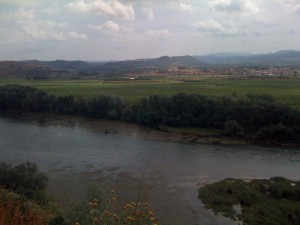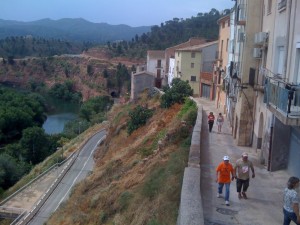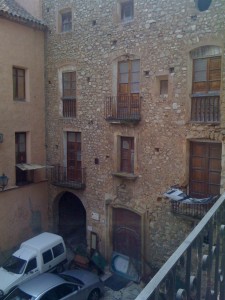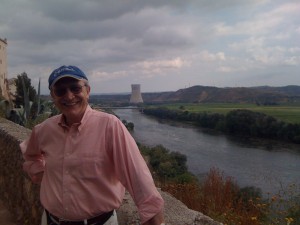Spain’s economy is in a death-spiral, with unemployment approaching 50% for people under 30 and holding at nearly 20% overall. As Spain’s frothy real estate market subsided, its golf industry crumpled with the grace of a train derailment. So I was a little surprised when I received a letter from a Spanish colleague telling me that a small town in Catalonia was looking into developing a golf course as a part of its new mayor’s strategy to diversify the local economy.
The town of Ascó lies along the Ebro River about sixty miles west of Tarragona, where the Ebro delta spills into the Mediterranean. A couple of millenia ago Hannibal marched up the Ebro valley on his way to the Alps, perhaps pausing in the plains near Ascó to give his elephants and troops a breather. The Ebro then separated Rome’s Iberian provinces from Carthage. The view from Ascó today is serene, with the silhouette of the coastal mountains scratched across the eastern horizon and a chain of villages tucked into the lower slopes, alternating like foot prints up the valley.
What lies to the north, however, defines modern Ascó. The massive cooling tower of a nuclear power plant nearing the end of its useful life sits in the foreground, dominating its bucolic surroundings. Ascó is in the running as a depository for Spain’s nuclear waste, an assignment that would bring jobs and a certain economic stability. The staff required to maintain the nuclear facilities, would, the mayor hopes, provide potential golfers. He also imagines a marina for pleasure boats built in concert with the golf course, as well as hotels and a restored historic town center all working together to create a destination. Visitors could sail up the Ebro, or drive up on the heels of Hannibal. Although it is a small town, Ascó has a long and rich history, reflecting the essential themes of Iberia’s past.
Coming to Ascó had given me an excuse to visit Barcelona, where a friend I have known for fifty years now lives. Ignacio A. had a long career in the UN before retiring recently to Barcelona. His last posting was in Japan, and he lived many years in Kenya. We’ve been friends since high school, but we haven’t seen much of each over these intervening years.
At the time we met, Ignacio was unlike anyone I had ever known— cosmopolitan and sophisticated, speaking English with a Spanish accent, reflecting mostly his Mexican birthplace but also holding traces of Ecuador, where he had lived for several years, and the Castilian lisp of his parents. He was the first person I ever heard say “ciao.” I thought I heard him saying “chow, mami” to his mom when we were leaving his house, and asked him what he meant. It’s an Italian word, he said, and spelled it for me—“people use it all over Latin America, not just in Italy,” he explained. This was very exotic to a boy who had never been east of the Wabash River nor further west than St Louis.
Why Ignacio was in Spain was a little complicated. He had been divorced from his third wife a few years before, and was looking for a city with a rich cultural life to enjoy as a single man. But Spain attracted him also as the homeland of his parents, who, as refugees from Franco’s fascist regime, had been welcomed into what they presumed would be a brief period of expulsion by a sympathetic Mexican government in 1938. Exile for his parents would be their permanent state—his mother would return to her homeland only in death, and is buried in Catalonia. His father never returned, but built a distinguished career as an archeologist in Mexico, which is what brought Ignacio to Carbondale, Illinois in 1960.
Southern Illinois University had been a teachers’ college until after WW II, when it became a university. In order to build its reputation as a seat of higher learning, SIU offered sinecures to a number of prominent retired academics from places like Harvard and Columbia, as well as professorships to people with international reputations, such as Ignacio’s father. Bucky Fuller, for example, led a design department that was cutting-edge in the 60s, studying human impacts on the environment—spaceship earth and all that. Ignacio, in fact, would attend SIU as an undergraduate and study in Fuller’s department before going off to Cornell for a Ph.D.
I arrived in Carbondale by a less glamorous route—driving down highway 51 from Centralia. My dad had died when I was in eighth grade, and my mom, who was a 36 year old housewife with three kids and no money, decided to go to college. She did this first at the junior college in Centralia, starting her college freshman year the same year I started mine in high school—and in the same buildings. In retrospect I cannot admire more what she would go on to accomplish, but at the time it was not cool to have your mom ask you how you were when she saw you in the hallway between classes. I mean, you’re in high school, for god’s sake—you’re practically grown—you don’t need your mom spying on you all day. So when, after two years at JC, my mom said she wanted to move to Carbondale so she could continue her studies, I was happy to be heading off to a place big enough that I was unlikely to bump into my mom when I wasn’t eager to see her.
And so it was that Ignacio and I met as high school juniors, immigrants to a new town, converging from different worlds. Because most of the students in the high school we attended were children of academics, they were more open-minded to outsiders coming in than kids in other schools might have been. Our class was also very small, which made it easier to identify the key people who were running the social show. Many of us have remained close over the years. Ignacio, too, seemed full of self-confidence, and even wore a suit to school when the rest of us wore shirts and jeans. In any case, he and I both managed to adjust, new boys with some of the same worries who enjoyed each other’s company.
Now, decades later, here we were driving to Ascó on a rainy Sunday morning, reminiscing about Carbondale, catching up on each other’s kids (he has four daughters, I have two) and sharing our mutual astonishment about being as old as we are. Our worlds touched in another curious way, too. Ignacio is an expert on development, but not the kind associated with the clients I normally work with, who call themselves developers. Ignacio worked at the base of the economy, while I work near the apex. Ignacio was concerned about rural poverty, about how you assemble the resources to launch people toward economic self-sufficiency, provide education and resources for women, and build social structures that can resist the obliterating grasp of political corruption. I was working with developers selling real estate and resort homes to people with disposable income thousands of times higher that Ignacio’s “clients” possessed. My clients often provided jobs to the people Ignacio’s work focused on, but otherwise the distance between the two worlds was wide and deep.
We also talked about Ignacio’s father’s experiences as an artillery captain in the Republican Army, which fought its last stand along the Ebro, up and down the valley where Hannibal had marched. The battles here in 1938 were vicious. The most famous memento of the Spanish Civil War is Guernica, Picasso’s lament for the Basque town destroyed by German and Italian bombers in 1937. Any civil war devastates civilian populations caught in the surge of battle, but the Spanish Civil War was particularly vicious because of its ideological rigidities. Franco hated the Catalonians, which added to the ardor of the battles along the Ebro. It was a take-no-prisoners world. Ignacio’s father was badly wounded in his leg. I remember him walking with a pronounced limp, always wearing the khaki outfit of the field archeologist. Although he was a prominent professor, he never wore a tie that I can recall. He also never learned to speak English well, although he was proficient enough to publish in English. His accent was very strong.
“He was in a city hall of a town,” Ignacio said, recalling what he could of his father’s injury, “when German bombers attacked. They made a direct hit and the building collapsed. His comrades started digging people out, and somehow found him alive under all the rubble. The torsos and heads of dead soldiers stuck up from the debris, but he stayed alive completely buried. But his leg was caught against something, and when they tugged to pull him out, it sliced off most of the muscle on his thigh. So he always thought it was ironic that he was injured in the rescue, not the bombing.”
We arrived in Ascó at mid-morning, and called our contact, Albert (pronounced with a hard second syllable, Catalan style.) Albert is an engineer and the cousin of the mayor’s wife. He lives in Barcelona but his family is from Ascó, and he has restored a family house overlooking the river and Hannibal’s trail. He met us for a coffee, followed by a tour of the village.
Ascó seemed very quiet, even for a Sunday morning. As we drove the few blocks up to his house, Albert pointed out signs commemorating the 500th anniversary of the expulsion of the Moors. “On Monday,” he told us, “boats will re-enact the expulsion, sailing down the Ebro with people in costume playing the parts of the Moors. Ascó was a Moorish city for 700 years.”
We walked down to the promenade overlooking the river below Albert’s house, where Rafael the mayor joined us. A small, tidily-dressed and affable man, Rafael pointed across the river to where he hoped the golf course would go. The site was flat, but its proximity to the river and the views of the mountains more than made up for the absence of land forms, which the golf course architect can create. The town tucked into a very steep bank rising on an almost perpendicular slope from the river below.
We were interrupted by the rasp of a loudspeaker, and Albert and Rafael pulled us aside as a tiny car rolled by, followed by four or five young men huffing up the incline, numbers pinned to their chests. “It’s a race for the village,” Albert said. The racers came by first, and after them casual runners, and before too long abuelas pushing buggies and men strolling along enjoying cigars. Almost everyone greeted the mayor, who smiled modestly to acknowledge the recognition. Now we knew why the town was so quiet—everyone was getting ready for the run.
As we walked toward the house of the local caballero, which the town is restoring, Albert and Rafael pointed out bullet holes still evident in the walls of buildings from the fighting more than seven decades ago. “German planes bombed Ascó in 1938,” Rafael told us. “A lot of the city was destroyed then, and not all of it was built back.” The fighting, he said, went back and forth across the river, with Republicans sometimes in charge, given way and then re-taking the town from the fascists. A lot of artillery shells hit the town. “My grandfather was a Republican at first,” Albert says, “but after he was captured he had to change sides.”
Ignacio took a deep breath as he looked across the river. Later, as we were driving back to Barcelona, he said, “I tried to see my father out there, a young man fighting for his country.” It is probably impossible to ever learn whether or not Ignacio’s dad fought in Ascó. The Republicans burned a lot of the archives as they were preparing to flee Madrid, and almost all of the participants in those events are now dead.
In 2002, Ignacio became a citizen of Spain, after a law was passed welcoming back children born of refugee parents. He was glad he could take advantage of this law, but Ignacio was also cynical about the reason for it. “It was not so much to honor the victims of Franco as it was to get more of ‘us’ in Spain—that is ‘real’ Spaniards, rather than immigrants. You know that story—it’s a kind of variation of what’s going on the USA now—‘taking the country back.’”
And of course modern Spanish history begins with the conclusion of the centuries-long wars known as the Reconquista—the expulsion of the Moors, which the people of Spain would be celebrating the Monday after we left Ascó. Spain’s ascendency to power in early modern Europe was accelerated by the simultaneous discovery of the New World, with all its riches. Not just the Moors were expelled from Spain, but the Jewish countrymen, too—excepting the ones who agreed to convert to Catholicism. So the Spaniards took their country back, with consequences that resonate to this day.
In the United States, part of the tea party rhetoric espouses “taking our country back.” The obvious question, apart from “why?” is “from whom?” President Barack Obama, of course, whose life has followed a uniquely American trajectory—risen from humble roots solely by merit, like the greatest of our presidents, Abraham Lincoln–seems somehow “foreign” to his fanatical opponents, who raise spurious issues like his place of birth. But it’s the immigrants from Mexico who really spark the ire of the tea-partiers. They are somehow “taking” the country. Many of these immigrants are descendents of people conquered by the Spanish in wars perpetrated by soldiers who learned their trade expelling Moors from Iberia. They called their north American possessions the Viceroyalty of New Spain, and its territories stretched north to modern-day California and the southwest, including Texas.
Ignacio’s father excavated many famous Aztec sites in the valley of Mexico, and part of his research was supported by the Church of Jesus Christ of the Latter Day Saints—the Mormons. Their theology led them to believe that the golden tablets would be found in Mexico. Ignacio’s dad was happy to take their money—he couldn’t know for sure what he might find. While he was teaching in Carbondale, Ignacio’s dad, whose name was Pedro, went up to Nauvoo, Illinois, where the Mormons had one of their first important settlements, before suspicious nativists drove them out and burned down their town. It was an early American example of “taking our country” back. Pedro was doing an archeological reconnoiter—and this long before the modern restoration of Nauvoo which has taken place over the last couple of decades. Mormonism floats securely in the mainstream of modern America.
So here was a bearded, limping middle-aged foreigner wearing workmen’s clothes walking around places the local constabulary decided he didn’t belong. His strong accent betrayed him. He was arrested for vagrancy and put in jail. After a couple of days his absence was noticed. This was the pre-Miranda era. And so it was that a distinguished professor languished in an Illinois jail cell in 1959 because he looked as if he did not belong.




